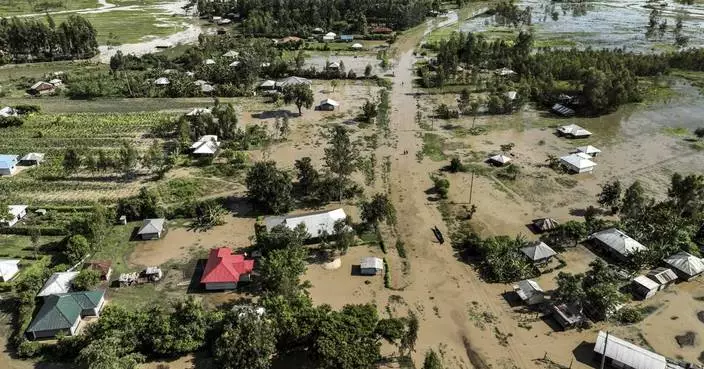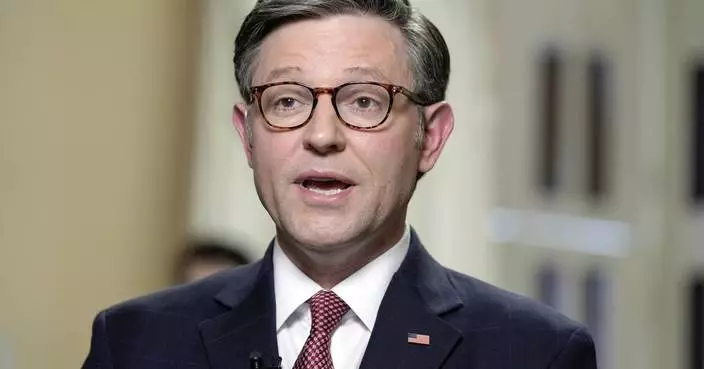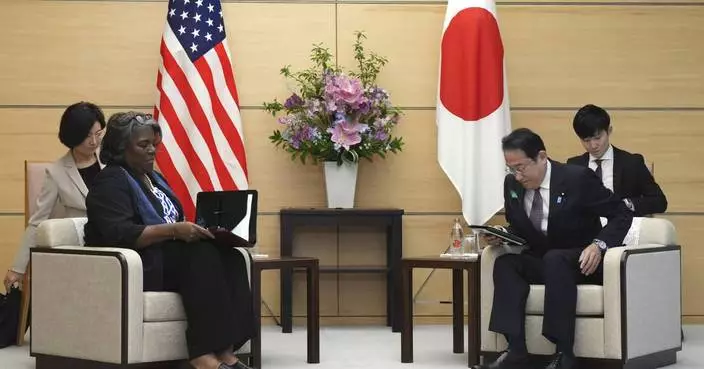The world must do more to help millions of refugees across sub-Saharan Africa, which hosts more than a quarter of the world's refugees, the United Nations said Tuesday.

U.N. refugee chief Filippo Grandi, center-right, visits a hospital as he tours Dadaab refugee camp, which currently hosts over 230,000 inhabitants, in northern Kenya Tuesday, Dec. 19, 2017.(AP Photo/Ben Curtis)
U.N. refugee chief Filippo Grandi spoke to reporters while visiting what until recently was the world's largest refugee camp, Dadaab, in Kenya.
Click to Gallery
The world must do more to help millions of refugees across sub-Saharan Africa, which hosts more than a quarter of the world's refugees, the United Nations said Tuesday.
U.N. refugee chief Filippo Grandi spoke to reporters while visiting what until recently was the world's largest refugee camp, Dadaab, in Kenya.
Kenya's government wants Dadaab, which hosts over 230,000 inhabitants, shut down, but the U.N. is urging patience and says all repatriations must be voluntary. A Kenyan court ruled in February that the government must not close Dadaab to refugees.
The U.N. says more than 32,000 Somalis have returned home this year from camps in Kenya under a voluntary repatriation program. Human rights groups have raised concerns about refugees being pressured to leave, either by Kenyan authorities or by the cut in rations by 30 percent in October.
Kenya was the last leg of a trip during which Grandi also visited Djibouti and Somalia. He said he met some former refugees who have happily settled in Somalia and others who face challenges and need help. Returning home is a "difficult, brave choice" as Somalia remains fragile, he said on Twitter.
"We will need to be strong and continue to help Somalia be strong, so that also conditions will be in place better for people to come back," Grandi said. "At the moment, in many areas there is a lot of insecurity, there is drought, there is other difficulties, lack of infrastructure."
The first settlement in Dadaab was established in 1991, when refugees fleeing conflict in Somalia started to cross the border into Kenya, according to the U.N. refugee agency.
Somali refugee boys recite the Koran at a Madrassa, or Islamic religious school, at Dadaab refugee camp, which currently hosts over 230,000 inhabitants, in northern Kenya Tuesday, Dec. 19, 2017.(AP Photo/Ben Curtis)
Somali refugee boys recite the Koran at a Madrassa, or Islamic religious school, at Dadaab refugee camp, which currently hosts over 230,000 inhabitants, in northern Kenya Tuesday, Dec. 19, 2017. (AP Photo/Ben Curtis)
A Somali refugee girl walks past the fence surrounding a hut at Dadaab refugee camp, which currently hosts over 230,000 inhabitants, in northern Kenya Tuesday, Dec. 19, 2017. (AP Photo/Ben Curtis)
"You know, it is very difficult to fund programs in Africa. I am not ashamed to say it," Grandi said, adding that he fights "all the time" for more aid. Some of the world's poorest countries, including Uganda and Ethiopia, host hundreds of thousands of refugees from South Sudan and elsewhere.
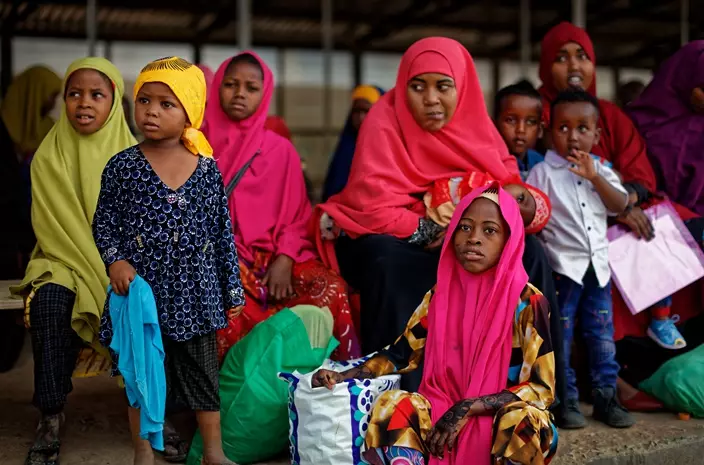
Some of around 20 Somali refugee families wait to be flown to Kismayo in Somalia, under a voluntary repatriation programme, at the airstrip of Dadaab refugee camp, which currently hosts over 230,000 inhabitants, in northern Kenya Tuesday, Dec. 19, 2017. (AP Photo/Ben Curtis)
Kenya's government wants Dadaab, which hosts over 230,000 inhabitants, shut down, but the U.N. is urging patience and says all repatriations must be voluntary. A Kenyan court ruled in February that the government must not close Dadaab to refugees.
Some Kenyan officials have argued that the sprawling camp near the border with Somalia has been used as a recruiting ground for the Islamic extremist group al-Shabab and a base for launching attacks inside Kenya. But Kenyan officials have not provided conclusive proof of that.

Ahmed Hussen, left, Canada's Minister of Immigration, Refugees & Citizenship who was born and raised in Somalia and immigrated to Canada in 1993, speaks to a Somali refugee family who fled from Kismayo six years ago, and translates the conversation to U.N. refugee chief Filippo Grandi, right. (AP Photo/Ben Curtis)
The U.N. says more than 32,000 Somalis have returned home this year from camps in Kenya under a voluntary repatriation program. Human rights groups have raised concerns about refugees being pressured to leave, either by Kenyan authorities or by the cut in rations by 30 percent in October.
While touring Dadaab, Grandi spoke to about 20 families of Somali refugees who are set to return home. The U.N. refugee agency says about 19,000 refugees in Dadaab are "in the pipeline" to return to Somalia.
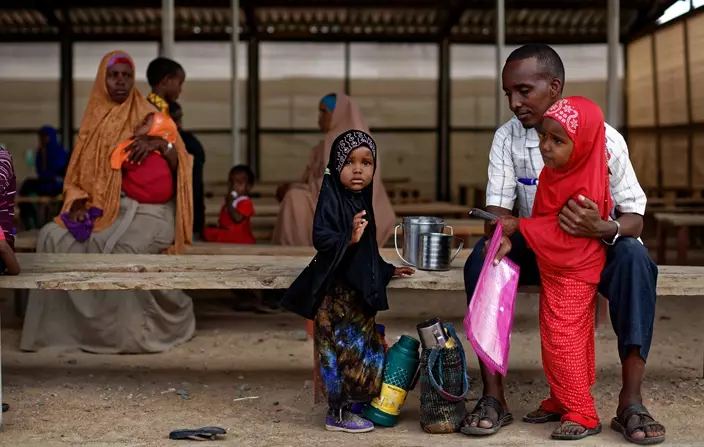
Some of around 20 Somali refugee families wait to be flown to Kismayo in Somalia, under a voluntary repatriation programme, at the airstrip of Dadaab refugee camp, which currently hosts over 230,000 inhabitants, in northern Kenya Tuesday, Dec. 19, 2017.(AP Photo/Ben Curtis)
Kenya was the last leg of a trip during which Grandi also visited Djibouti and Somalia. He said he met some former refugees who have happily settled in Somalia and others who face challenges and need help. Returning home is a "difficult, brave choice" as Somalia remains fragile, he said on Twitter.
Some parts of Somalia are witnessing drought conditions, and the al-Qaida-linked al-Shabab frequently carries out deadly attacks, especially in the capital, Mogadishu. A truck bombing in October killed 512 people.

Some of around 20 Somali refugee families wait to be flown to Kismayo in Somalia, under a voluntary repatriation programme, at the airstrip of Dadaab refugee camp, which currently hosts over 230,000 inhabitants, in northern Kenya Tuesday, Dec. 19, 2017. (AP Photo/Ben Curtis)
"We will need to be strong and continue to help Somalia be strong, so that also conditions will be in place better for people to come back," Grandi said. "At the moment, in many areas there is a lot of insecurity, there is drought, there is other difficulties, lack of infrastructure."
Many refugees he spoke to said they would not return home if the situation does not improve, he said.
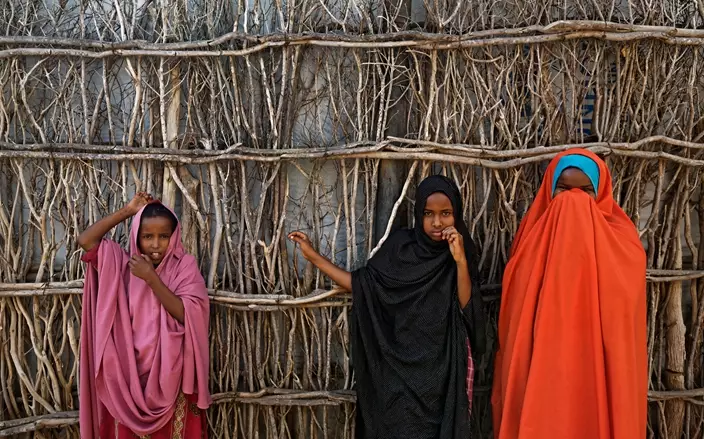
Somali refugee girls stand by the fence surrounding their hut at Dadaab refugee camp, which currently hosts over 230,000 inhabitants, in northern Kenya Tuesday, Dec. 19, 2017. (AP Photo/Ben Curtis)
The first settlement in Dadaab was established in 1991, when refugees fleeing conflict in Somalia started to cross the border into Kenya, according to the U.N. refugee agency.

Somali refugee girls run to see the commotion during a visit of U.N. refugee chief Filippo Grandi, at Dadaab refugee camp, which currently hosts over 230,000 inhabitants, in northern Kenya Tuesday, Dec. 19, 2017. (AP Photo/Ben Curtis)
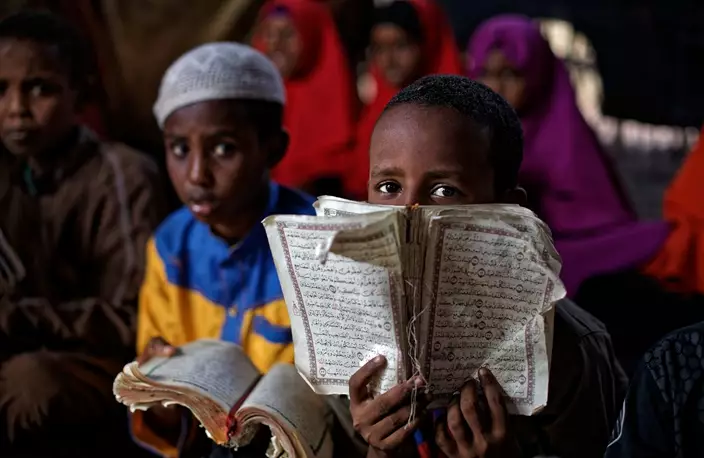
Somali refugee boys recite the Koran at a Madrassa, or Islamic religious school, at Dadaab refugee camp, which currently hosts over 230,000 inhabitants, in northern Kenya Tuesday, Dec. 19, 2017.(AP Photo/Ben Curtis)
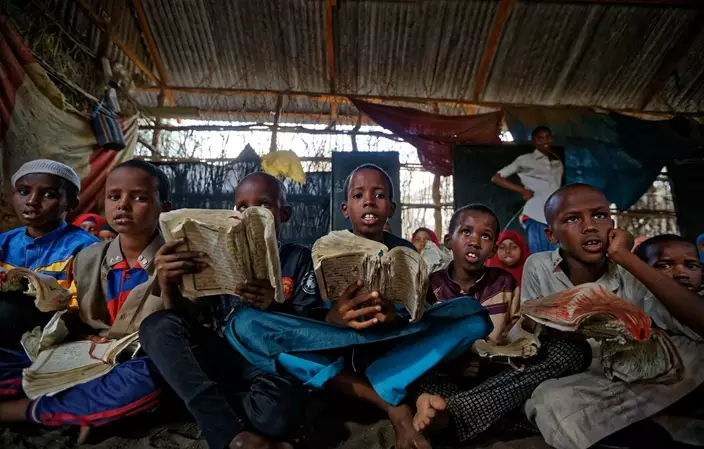
Somali refugee boys recite the Koran at a Madrassa, or Islamic religious school, at Dadaab refugee camp, which currently hosts over 230,000 inhabitants, in northern Kenya Tuesday, Dec. 19, 2017. (AP Photo/Ben Curtis)
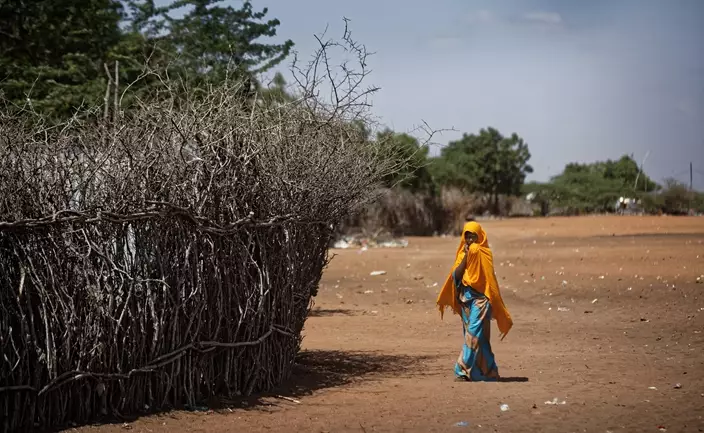
A Somali refugee girl walks past the fence surrounding a hut at Dadaab refugee camp, which currently hosts over 230,000 inhabitants, in northern Kenya Tuesday, Dec. 19, 2017. (AP Photo/Ben Curtis)
UNITED NATIONS (AP) — The United Nations called Tuesday for “a clear, transparent and credible investigation” of mass graves uncovered at two major hospitals in war-torn Gaza that were raided by Israeli troops.
Credible investigators must have access to the sites, U.N. spokesman Stephane Dujarric told reporters, and added that more journalists need to be able to work safely in Gaza to report on the facts.
Earlier Tuesday, U.N. human rights chief Volker Türk said he was “horrified” by the destruction of the Shifa medical center in Gaza City and Nasser Hospital in the southern city of Khan Younis as well as the reported discovery of mass graves in and around the facilities after the Israelis left.
He called for independent and transparent investigations into the deaths, saying that “given the prevailing climate of impunity, this should include international investigators.”
“Hospitals are entitled to very special protection under international humanitarian law,” Türk said. “And the intentional killing of civilians, detainees and others who are ‘hors de combat’ (incapable of engaging in combat) is a war crime.”
U.S. State Department spokesman Vedant Patel on Tuesday called the reports of mass graves at the hospitals “incredibly troubling” and said U.S. officials have asked the Israeli government for information.
The Israeli military said its forces exhumed bodies that Palestinians had buried earlier as part of its search for the remains of hostages captured by Hamas during its Oct. 7 attack that triggered the war. The military said bodies were examined in a respectful manner and those not belonging to Israeli hostages were returned to their place.
The Israeli military says it killed or detained hundreds of militants who had taken shelter inside the two hospital complexes, claims that could not be independently verified.
The Palestinian civil defense in the Gaza Strip said Monday that it had uncovered 283 bodies from a temporary burial ground inside the main hospital in Khan Younis that was built when Israeli forces were besieging the facility last month. At the time, people were not able to bury the dead in a cemetery and dug graves in the hospital yard, the group said.
The civil defense said some of the bodies were of people killed during the hospital siege. Others were killed when Israeli forces raided the hospital.
Palestinian health officials say the hospital raids have destroyed Gaza’s health sector as it tries to cope with the mounting toll from over six months of war.
The issue of who could or should conduct an investigation remains in question.
For the United Nations to conduct an investigation, one of its major bodies would have to authorize it, Dujarric said.
“I think it’s not for anyone to prejudge the results or who would do it,” he said. “I think it needs to be an investigation where there is access and there is credibility.”
The chief prosecutor of the International Criminal Court, Karim Khan, said after visiting Israel and the West Bank in December that a probe by the court into possible crimes by Hamas militants and Israeli forces “is a priority for my office.”
The discovery of the graves "is another reason why we need a cease-fire, why we need to see an end to this conflict, why we need to see greater access for humanitarians, for humanitarian goods, greater protection for hospitals” and for the release of Israeli hostages, Dujarric said Monday.
In the Hamas attack that launched the war, militants killed about 1,200 people, mostly civilians, and abducted around 250 hostages. Israel says the militants are still holding around 100 hostages and the remains of more than 30 others.
In response, Israel’s air and ground offensive in Gaza, aimed at eliminating Hamas, has killed more than 34,000 Palestinians, according to local health officials, around two-thirds of them children and women. It has devastated Gaza’s two largest cities, created a humanitarian crisis and led around 80% of the territory’s population to flee to other parts of the besieged coastal enclave.
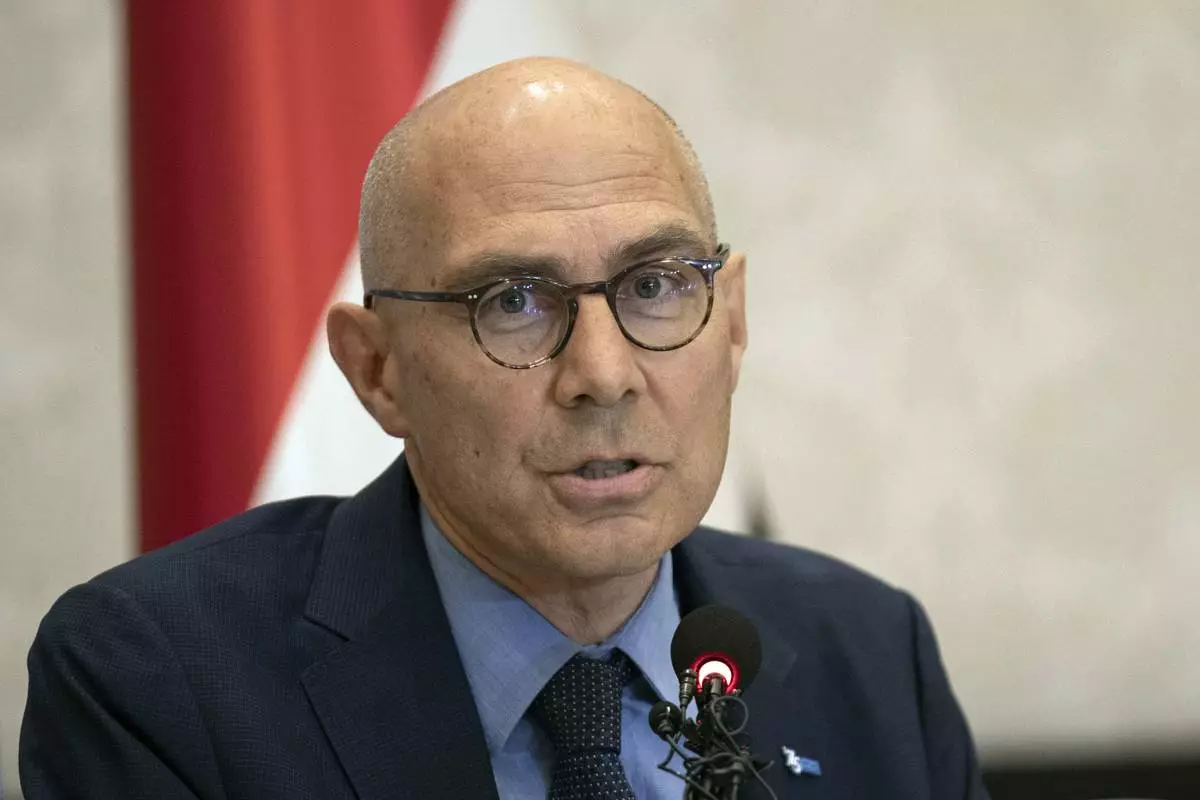
FILE - U.N. High Commissioner for Human Rights Volker Turk, speaks during a news conference in Baghdad, Iraq, Aug. 9, 2023. The United Nations is calling for "a clear, transparent and credible investigation" of mass graves uncovered at two major hospitals in war-torn Gaza that were raided by Israeli troops. (AP Photo/Hadi Mizban, File)
















